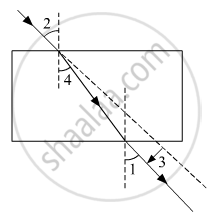Advertisements
Advertisements
प्रश्न
As light from a far off star comes down towards the earth:
(a) it bends away from the normal
(b) it bends towards the normal
(c) it does not bend at all
(d) it is reflected back
उत्तर
it bends towards the normal
As the light from a far-off star comes towards the earth, it bends towards the normal because the air is denser closer to the surface of the earth.
APPEARS IN
संबंधित प्रश्न
The correct sequencing of angle of incidence, angle of emergence, angle of refraction and lateral displacement shown in the following diagram by digits 1, 2, 3 and 4 is:

(a) 2, 4, 1, 3
(b) 2, 1, 4, 3
(c) 1, 2, 4, 3
(d) 2, 1, 3, 4
The phenomenon that causes the twinkling of stars is refraction of light.
Fill in the following blank with suitable word:
We can see the sun about ................ minutes before the actual sunrise and about ................ minutes after the actual sunset because of atmospheric ................
Why do stars seem higher than they actually are? Illustrate your answer with the help of a diagram.
The stars twinkle but the planets do not twinkle at night because:
(a) the stars are small but the planets are large
(b) the stars are very large but planets are small
(c) the stars are much nearer but planets are far off
(d) the stars are far off but planets are nearer to earth
Why does the sky appear blue on a clear day?
What causes the scattering of blue component of sunlight in the atmosphere?
The air layer of the atmosphere whose temperature is less than the hot layer behave as optically:
Refraction of light by the earth’s atmosphere due to variation in air density is called ____________.
Assertion: Sky appears blue in the day time.
Reason: White light is composed of seven colours.
